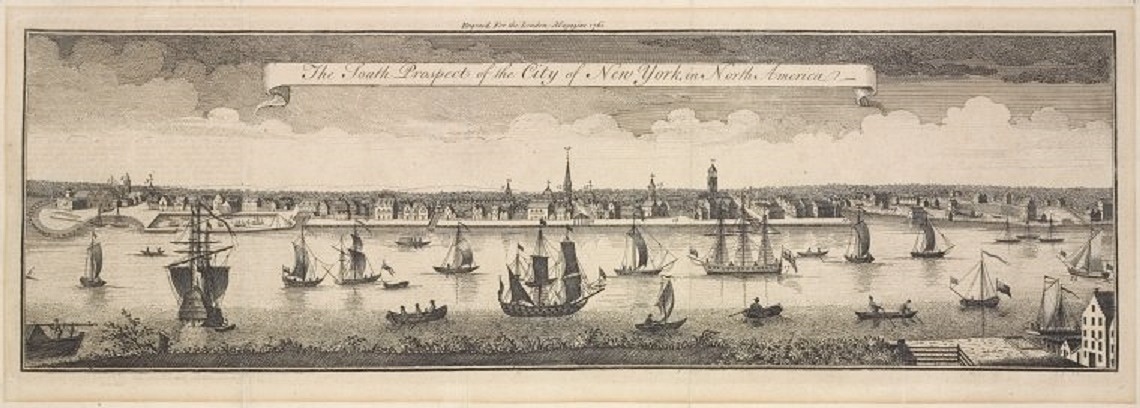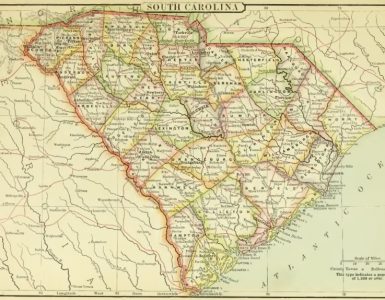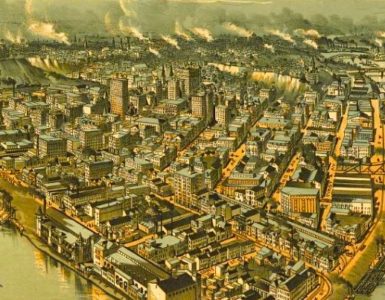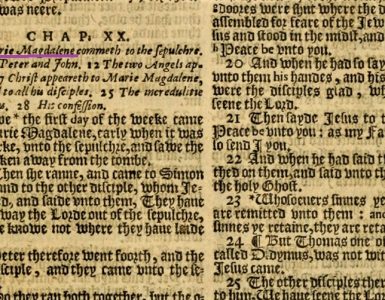The post last week was a biography of Swiss-American Philip Milledoler and for this week the Dutch-Americans will be the subject. The Dutch settled New Amsterdam in the early seventeenth century. Their influence was important to the development and growth of the colony and at the time of Milledoler’s death, the Reformed Dutch Church had a substantial presence in what had been renamed New York. Basketball fans know of the New York Knicks. The name is adapted from the Dutch word Knickerbockers, which refer to knee length pants reminiscent of those worn by apologist Francis Schaeffer and golfer Payne Stewart. But more importantly, the Dutch brought Reformed theology to America in their confessional standards, The Belgic Confession, The Canons of Dort, and The Heidelberg Catechism (The Three Forms of Unity). These documents are enjoying a confessional renaissance in some Reformed circles today. The article from the New York Daily Tribune that follows tells about the Reformed Dutch Church in New York from the early seventeenth century up to the time of Milledoler’s death. Included at the end is a list of the churches in New York and the succession of ministers in the Collegiate Dutch Church. You will notice that two of the churches listed are German; the Dutch and German churches sometimes enjoyed a close relationship. Sometimes in America, German Reformed and Lutherans, despite their different theologies, met together for services because of their common culture and language.
Some readers may find the term “collegiate church” unfamiliar. For the Reformed Dutch, a collegiate church had more than one worship location and any minister of the church was considered a pastor for all locations. It is not a precise analogy, but physicians often have two or three offices and every patient is considered a part of the whole practice, but the physician does not meet with them all in the same place. A collegiate church was a good idea for the congregants because a building could be close to home, but it may have been challenging for the ministers as they moved from site to site. As the years passed, both the Reformed Dutch (or Dutch Reformed) and Presbyterians either separated their collegiate locations into autonomous churches or merged them into single properties.
I have done my best to get the several Dutch names transcribed accurately, but due to the poor clarity of the font and age of the newspaper scanned into digital form, the identification of letters was difficult. Any term in brackets [ ] has been inserted and a [?] at the end of a word indicates uncertainty about the precision of the transcription. Words with underlined portions instead of letters indicate the letters were indecipherable.
Barry Waugh
The Reformed Dutch Church in New York
New York Daily Tribune, September 27, 1852
The Dutch Reformed Church in this City is a patriarchal institution. It was established very soon after the East India Company’s colony settled in the wilderness now transformed into the Battery. We are aware of the existence of a regular Church aa early aa l626; and from 1639 to the present day there are unbroken Church records kept for nearly a century in the Dutch language, and thence forward in the English. The Reformed Dutch Church was the pride of the Ancient Knickerbockers, very few of whom could ever look with complacency upon its early rival—the Episcopal, or Church of England organization. For a century and a half the ministers, kerkmeesters [church wardens] and people, obstinately refused to hear the Word in any other tongue than that in which Bogardus and the Megapolenses had taught and prayed; and when, after the city had been under English rule for nearly a hundred years, it was proposed to dispense the Word in the vulgar, the proposition met with vigorous opposition, and was agitated and debated for years. Finally the innovators triumphed; the rapid increase of the English language made the reform absolutely necessary; a minister who could preach in English was called and on the afternoon of the last Sabbath in March 1764, Rev. Archibald Laidle, D.D., gave the first English Dutch Reformed sermon in the Middle Dutch Church—now the Post office—from 2 Corinthians, 5:11, “Knowing, therefore, the terror of the Lord, we persuade men.” All the services were conducted in English except the singing—the idea of singing in barbarous English was too much, and no sooner had the worthy Scotch dominie indicated the psalm than Jacobus Van Antwerp, the “fore-singer,” led off in good old sonorous Dutch. The house was densely crowded by the first men of the city, Mayor Cruger, Aldermen Roosevelt, Rapalje, Byvanck, and others. But this was only a compromise, after all; for before the advocates of pure Dutch surrendered, they stipulated that the language of their ancestors should have at least one portion of each Sabbath. The English language, however, was destined to prevail, and somewhere in the beginning of the present century Dutch went out of use in all the churches—in fact, it was practically dead at an earlier period; and now we doubt if any of the younger ministers of the Church can read a page of it.
The First Reformed Dutch Church edifice in this city, was within the Fort, and was erected by Gov. Willem Kieft, in 1649. De Vries says, “As I was every day with Commander Kieft, I told him that, as he had now made a fine tavern (the Statherberg, at Coenties-slip), we also wanted very badly a Church; for until then we had nothing but a mean barn, in appearance, for our worship; whereas in New England, their first concern was a fine church, and we ought to do the same. Wherefore I told him I would contribute a hundred builders, and he, as Governor, should precede me. Whereupon we agreed and chose Jochem Pietersen Ruyter, I.C., Daman, and ourselves, as four kerkmeesters to superintend the building. John and Richard Ogden contracted to build the same of stone for 2,500 guilders. It was to be seventy feet by fifty-two feet, and sixteen feet high. This house answered the demands of the people of that faith for fifty years. While the English ascendency of 1664 continued, the Chapel was occupied by English dissenters, and called King’s Chapel; the ejected Dutchmen worshiping where they might, under the ministrations of Revs. Samuel Drissius, Rev. Wilhelminus van Nieuennuysen, D.D., and Henricus Selyas, the latter of whom officiated in Gov. Stuyvesant’s Chapel at “The Bouerle” or farm (the site of the present St. Mark’s Church) every Sunday afternoon for a considerable period. This place was far beyond the city, many fine farms and woody hills intervening between the stubborn old Governor and the city which he had abandoned to English rule. In 1695 there were about 850 white families on Manhattan Island, of which nearly 600 were Dutch Reformed and Lutherans, 180 French Huguenots, 40 English dissenters, and 20 Jews; of the Dutch, there were 90 families at Harlem. The pastors were—Dutch, Dr. Henricus Selyns; French, Dr. Pierot; Jewish, Rabbi Saul Brown.
The Peace of 1674 between Holland and England gave the city irrevocably to the British authorities and Churches again enjoyed repose and prosperity. Church edifices became necessary and within a few years quite a number were completed. The Dutch built the Garden Street Church, afterward called “The South Church,” on Garden Alley, now Exchange Place. The site was strongly opposed because it was “too far out of town.” The Church was built in 1693; it was a small structure of octagon form with a steeple in the center of the roof. In 1776 it was enlarged and improved, but the congregation did not prosper, and the last sermon ever preached in the original house was to only fourteen hearers. It was, closed for several years, but in 1897 it was rebuilt of stone and made 66 feet long and 50 wide, and a large congregation continued to assembly until 1813, when it separated from the Collegiate Church, and Rev. James M. Matthews, D.D., was installed pastor, where he continued until 1834, when he became Chancellor of he University, and Rev. Mancius S. Hutton took his place. The Church was burned in the great fire of 1835. It was decided to rebuild it near the corner of Murray and Church Streets; but some of the people resolved to remove further up town, and the result was the Garden Street Church became duplicated—the Murray Street Church was opened in 1817, Rev. John M. Macauley, pastor; the church on Washington Square was organized in April 1837, by 49 members of the Garden Street Church, Rev. Dr. Matthews and Rev. M. S. Hutton, pastors; Dr. Matthews resigned in 1842, and Rev. Dr. Hutton remains in charge at the present time.
Shortly after the building of the Garden Street Church another Reformed Dutch congregation was organized and put up a house of worship on Nassau Street, between Cedar and Litely Streets. This was called the “New Church” until the erection of a third building at the corner of William and Fulton Streets when it became known as the “Middle Dutch Church.” The edifice, which was a stupendous structure for those days, was opened in 1729. It is a substantial stone building, 100 by 70 feet. When first built it had no gallery, the ceiling was an entire arch, the pulpit being in the center of the east side. In 1764 the pulpit was removed to the north end, and a gallery was erected. During the Revolution the English officers used it for a riding school and a temporary prison, tearing down the pews and woodwork for fuel. After the war it was repaired and became one of the most important churches in the city, sending forth colonies here and thee with marvelous rapidity. In 1844, the congregation having mostly moved up town, the edifice was leased to the United States Government for a Post Office. A farewell meeting was held August 11; Dr. Knox preached, Dr. De Witt pronounced a benediction in the Dutch language, and the venerable old edifice was abandoned to Mammon.
The next commenced of the Dutch Church edifices of the past century was the building lately known as “Gosling’s Dining Saloon,” in Nassau Street, between John Street and Maiden Lane. The Congregation was originally styled “The German Reformed Congregation in New York,” and was composed of German Lutherans and Calvinists, who were unacquainted with Low Dutch; immigrants who understood that language generally uniting with the Garden Street and New (Middle) Churches. About 1758, these Germans purchased the Old Nassau Street Theatre for ₤1,250 and fitted it up as a place of worship. Rev. Mr. Rosencrantz was their first Minister. He had been preaching on the Mohawk but was driven off by the Indians. In 1763 under the advice of Rev. J. M. Kern, their pastor, the Congregation united with the Synod of North Holland, which movement brought them at once into connection with the Collegiate Dutch Church, and Rev. Mr. Kern was installed over them Jan. 27, 1764. A new building became necessary, and the corner stone thereof was laid March I, 1765, by the pastor, and then each member of the Consistory at the same time placing one stone on the foundation. The edifice was small, and of little architectural merit. Rev. Mr. Kern was succeeded in 1772 by Rev. C. F. Foering, and he by Rev. Mr. Gebherd, who stayed until the British invasion of 1775. During the war, services were irregular, but in 1783, Rev. J. D. Gross became pastor; and after him, in May 1795, Rev. Philip Milledoler (then only 20 years of age) was called, and continued pastor of the church about five years. Trying controversies then arose, and parties were arrayed against each other in the Church. Rev. Mr. Runkle, Rev. Mr. Dryer, and Rev. Mr. Smith officiated irregularly from 1800 to 1814. In 1814, Rev. Mr. Labagh was called and ministered in peace until 1822. The congregation then sold their house and erected a new one on Forsyth Street. The old house—subsequently a restaurant—was taken down five or six years ago. The dispute between the Lutherans and Calvinists of the congregation followed them to Forsyth Street and continued with much severity until 1834, when the Lutherans obtained entire possession of the house in virtue of a decision of the Chancellor. This finally separated the Church from its connection with the Collegiate Classis.
The last Dutch Church of the olden time, remaining to be noticed, is the “North Dutch Church” in Williams Street at the corner of Fulton Street. The rapid increase of the congregations of the Garden Street (South), and New (Middle) Churches, made more room imperatively necessary. In 1766, John Harpending, Esq., gave the ground on the 2nd of July 1767, the corner stone was laid, and on the 25th of May 1769, the “North Dutch Church” was opened for public worship. It is a fine stone building, 100 by 70 feet, with a lofty and symmetrical spire. The cost of the house was £11,948 9s 4d. This church remained in all respects as first built until 1842 when it was modernized in the interior; the outside, however, was untouched.
[Notice that all the churches in the following list had ministers except one, which contrasts with other denominations in the era that struggled with substantial shortages.]
Collegiate Church (the four ministers named led services in all three locations)
North Dutch, William at the corner of Fulton, T. W. Chambers, T. E. Vermilye
Ninth Street, Ninth Street near Broadway, John Knox
Collegiate, Lafayette Place, Thomas DeWitt
[Other Churches]
Broomingdale, Het Street and Rim. Road, E. Van A__en
Broome_t, Corner of Greete [?], G. H. Fisher
Frankhurst, Near Church Street, J. B. Hariesbergh
German Reformed, ______________ 20th Street, J. S. Enough
German Evangel. Mission, Houston near Forsyth, J. C. Guidin [?]
Greenest [?]. Fartuny corner of Hammond, W. H. Gordon
Greenwich, H______ at corner of Amos, N. I. Marseus
Harlem, Harlem, J. S. Lord
Livingston, Blind Asylum, Aaron Lloyd
Manhattan, Avenue B at corner of Fifth Street, F. F. Cornell
Market Street, Corner of Henry Street, Isaac Ferris
Mount Pleasant, Fortieth Street, [no minister]
South, Fifth Avenue at the corner of 21st, J. M. Macaulay
Twenty-First Street, Near Sixth Avenue, A. R. van Nest
Washington Square, Wooster Street, M. S. Hutton
West, Bleecker at the corner of Morton, Jos. McKee
These Churches have a membership in communion of probably six or seven thousand. The following list embraces the names of Pastors of the Collegiate Church, with the dates of their installation, dismissal, and death, so far as known:
Rev. Everarcus Bogardus, Died in 1617.
Rev. Johannes Megapolensis, and Rev. Samuel Megapolensis, brothers and colleagues in 1619. The last named was a physician. Samuel lived the longest, but both were dead in 1669.
Rev. Samuel Drissius, colleague with Rev. Samuel Megapolensis, Died —-.
Rev. Wilhelminus van Nieuennuysen, D.D., called from Holland in 1671. Removed to Breuklyn in 1676, but officiated in New York until his death in 1680.
Rev. Ben_icus Saiy_s, called from Holland to Brooklyn in 1660, and officiated there and at Gov. Stuyvesant’s Chapel for a year. Went to Holland but returned to the Collegiate church in 1682. Died in 1700.
Rev. Guslterius [?] Dubois, installed in 1699. Died in 1756.
Rev. Hebricus [?] Boel, served as colleague with Dubois in 1713, died in 1754.
Rev. Johannes H_z_ma, settled as colleague with Dubois and Boel in 1744; left the City at the commencement of the war in 1776, died at Kinderhook in 1796.
Rev. Lambertus DeRonde, settled in 1751; died at Schagucoke in 1795.
Rev. Archibald Laidle, D.D., called to preach in English in 1764; died at Redhook in 1778, aged 51.
Rev. John Henry Livingston, D.D., settled in 1780; resigned and made Professor of Theology at New Brunswick in 1810, where he died Jan. 20, 1825, aged 79.
Rev. William Linn, settled in 1785; dismissed on account of his health in 1805; died at Albany, Jan. 1808.
Rev. Gerardus A. Kuyper, installed May 1789; died June 28, 1833.
Rev. John N. Abeel, installed in 1795; died Jan. 19, 1812.
Rev. John Schureman [?], settled in 1809; elected Professor at New Brunswick and dismissed in 1811.
Rev. Jacob ___dread, D.D., installed in Dec. 1809’ resigned in 1813.
Rev. Philip Milledoler, D.D., settled in Feb. 1813; resigned in Feb. 1825, died Sept. 15 [22], 1852, aged 77.
Rev. Pascal N. Soron [?], ordained and installed July 14, 1816; died at St. Croix, April 7, 1825.
Rev. John Knox, D.D., ordained and installed July 14, 1816; still living.
Rev. William C. Brownlee, D.D., installed June 17, 1826; still living.
Rev. Thomas DeWitt, D.D., installed Sept. 16, 1827; still living.
Rev. Thomas E. Vermilye, D.D., installed Nov. 1839; still living.
Rev. T. W. Chambers, date of installation not known, still living.
Notes–The header image is “The south prospect of the city of New York, in North America,” 1761, and is from the New York Public Library Digital Collection, Image No. 53913.





